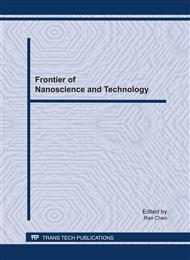p.538
p.543
p.549
p.554
p.559
p.565
p.570
p.575
p.580
Temperature Induced Morphology Transformation of ZnO under Hydrothermal Condition
Abstract:
ZnO nanostructures with different morphology were successfully prepared via a hexamethylendiamine-assisted hydrothermal synthesis route by only adjusting reaction temperature. The prepared ZnO samples were characterized by powder X-ray diffraction (XRD), field-emission scanning electron microscopy (FESEM), transmission electron microscopy (TEM) and high resolution TEM (HRTEM). Results indicated that uniform flake-like ZnO nanoparticles with a similar thickness of about 70 nm and flower-like ZnO nanostructures assembled by prism-like nanorods were prepared at 120 °C and 180 °C, respectively. Possible mechanisms for the formation of ZnO with different morphologies were discussed. The photocatalytic properties of the as-prepared flake-like ZnO nanoparticles and flower-like ZnO nanostructures were studied.
Info:
Periodical:
Pages:
559-564
Citation:
Online since:
July 2011
Authors:
Price:
Сopyright:
© 2011 Trans Tech Publications Ltd. All Rights Reserved
Share:
Citation:


